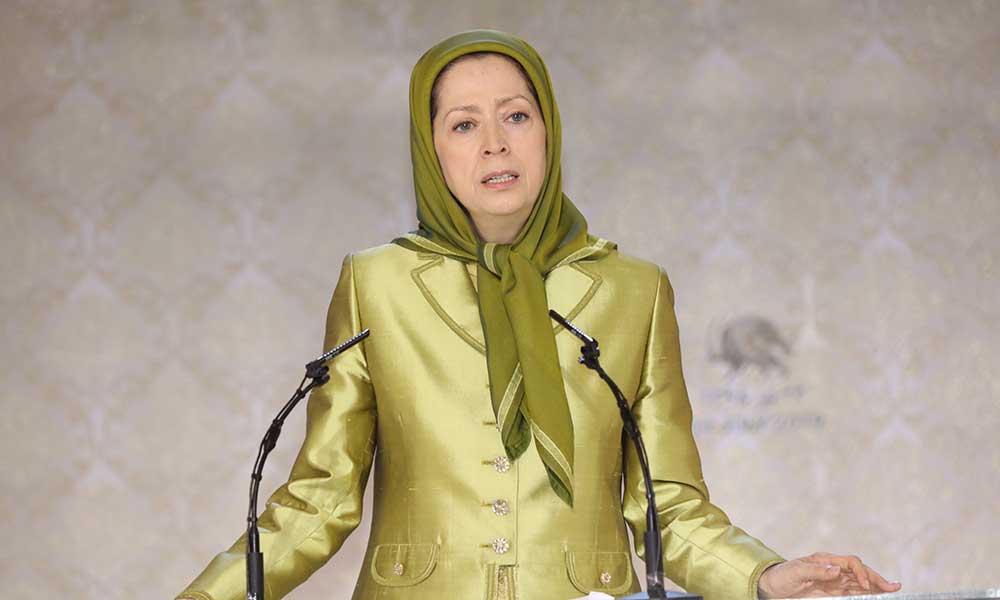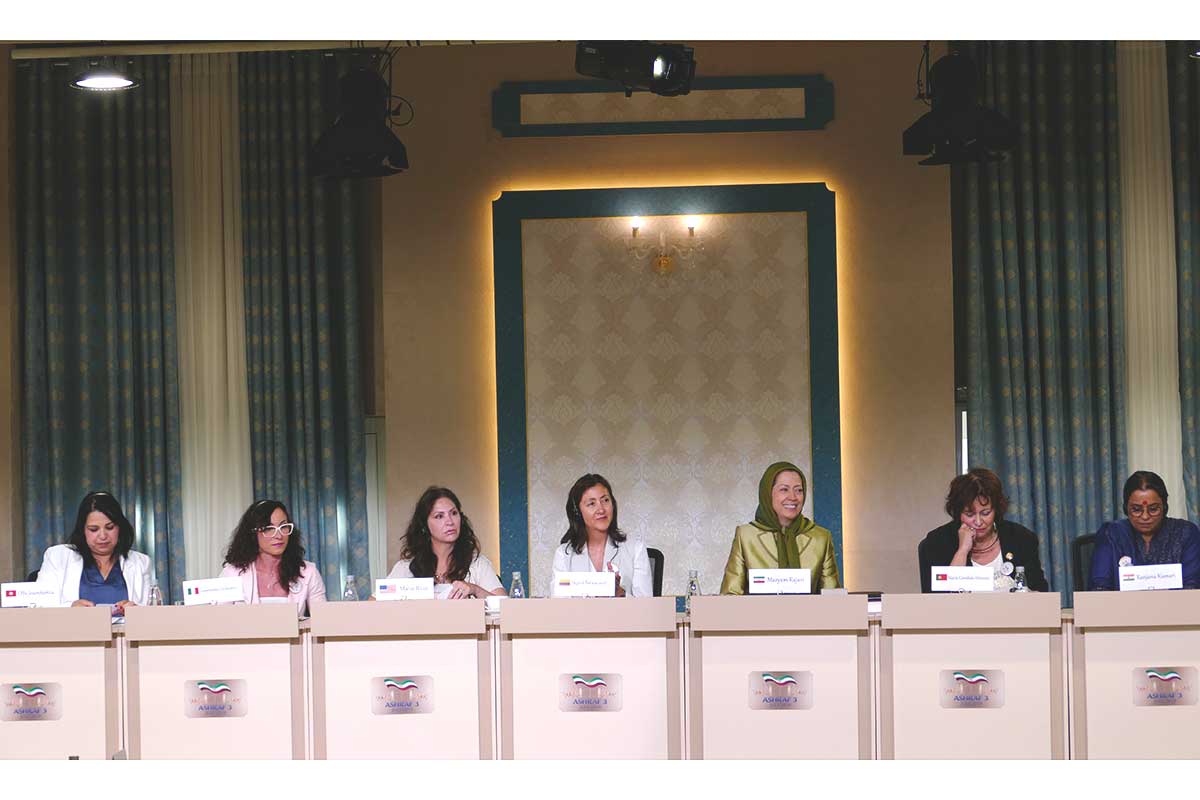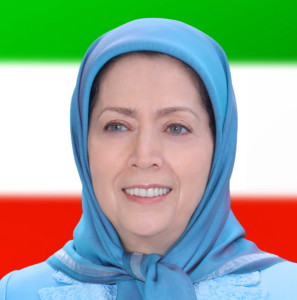Maryam Rajavi: Women’s progress in the Resistance movement is indebted to an incessant battle against reactionary and exploitative thinking

Speech to the international conference at Ashraf 3 on women’s leadership in the Iranian Resistance
Greetings to my dear sisters from Albania, European countries, the United States, Canada, Australia, Asia and Arab countries who are attending this conference.
I would also like to salute my dear sisters, members of the big family of Resistance. Welcome to Ashraf 3.
And I hail the members of the Central Council of the People’s Mojahedin Organization of Iran (PMOI/MEK), the majority of whom are participating in this gathering.
Such an assembly usually takes place on the International Women’s Day, but anywhere women come together to discuss their mission for freedom and equality, and for emancipation of society in general, that day becomes a day for women.
This is particularly true for the women of Iran because they are defying and resisting against a fundamentalist and reactionary regime, whose most distinctive feature is misogyny.
Before the current regime seized power in Iran, women participated in the uprisings in large numbers. This indicated a transformation in the status of women and their role in the democratic struggle. Women’s widespread participation in the anti-monarchic revolution had significant precedent in Iranian women’s past struggles. Specifically, in the 1970s, women actively participated in the revolutionary struggle against the Shah. Some of the most prominent among these pioneering women were Fatemeh Amini, Marzieh Uskowi, Azam Rouhi Ahangaran and Ashraf Rajavi. They made great sacrifices to open the path for the revolution.
The regime which took over in 1979, however, was misogynous and theocratic and retarded Iranian women’s progress.
I remember those days quite well. It seemed like a showdown between two opposing forces. The mullahs’ enmity against women, and the latter’s disdain for, and distrust in the new regime, started on the very day Khomeini took power.
As soon as the mullahs hijacked the revolution, they began their clampdown on women with the motto of “either the veil or a hit on the head.”
At the same time, women also started their resistance against this regime, which has continued to this day.
I would like to briefly review the status of Iranian women from a few different angles:
As for political participation, I must say that women have no role in the ruling regime and in its decision making at any level of its hierarchy.
Another issue is depriving women of their personal and social freedoms and their right to free choice. Women have been deprived of their rights to travel, marry and have a private life, choose their occupation, and the most pervasive of all, their free choice of clothing.
Another issue is the existence of hideous inequalities and discriminations against women under the rule of the clerical regime.
Drastic inequalities in job opportunities, in wages, in families, in education, in testimony before a court, in having access to medical services and insurance, in their share of inheritance, in access to sports fields and stadiums, and a long list of denial of rights in every realm.
Such discrimination in any society, at any juncture in history, would mean subjugation of the people, suppression, plundering and deprivation of political rights.
Another issue is promoting violence against women.
Women of Iran do not feel safe anywhere, not at the work place, not when they commute in the streets, and not even among their families. The regime enforces this clampdown through countless number of patrols, security forces and police tasked with offending and insulting and arresting women.
Inhumane treatment of women in prisons is common practice. Since Hassan Rouhani became president, some 90 women have been hanged.
A deeper look into the reason for the mullahs’ savagery towards women reveals that misogyny is the driving force and the essence of the regime’s suppression of the society in general.
I must also underline the rampant poverty and destitution in today’s Iran most of whose victims are women.
Over 62 percent of women above 10 years old are housewives. Those who have a job, are considered the world’s cheapest work force. Women make up half of the workers of brick kilns in Iran.
The average economic participation of women in the Middle East is 22 percent. But this rate is only 12 percent in the cities of Iran. This rate has not changed for over five decades.
In reviewing the status of 200 countries, the International Labor Organization announced that Iran is among six countries at the bottom of the list, namely among the war-stricken and shattered countries such as Syria and Iraq.
You must have heard the spin doctors of the regime claiming that if the mullahs were to be overthrown, Iran would experience chaos and disaster. This is while Iranian women are currently living in conditions reminiscent of and even worse than war-torn countries; they are suffering from poverty, destitution, unemployment and homelessness.
Look at the meager wages of young female workers and their agonizing work environments.
Young women with Bachelor’s or Master’s degrees are working for salaries of 10 to 20 dollars a month.
In fact, women are not only cheap laborers in Iran’s job market but also subjected to horribly oppressive working conditions.
We believe that the common answer to all these problems is freedom and equality. Not just equality and not just freedom. But both freedom and equality. This is the answer for the liberation of women. This is why I have always emphasized that women not only will free themselves but also their societies at large.
This is our mission and we are determined to carry it out.
My dear sisters,
A few minutes ago, I pointed to women’s widespread participation in the struggle against two dictatorships. Let me add that they have always been at the forefront of the struggle since the outset of the mullahs’ theocratic rule, and more significantly, they have been the trailblazers and leaders of this struggle.
Those days, women faced more difficulties than men in joining the democratic struggle. Young Muslim women, in particular, faced greater problems because before the founding of the People’s Mojahedin Organization of Iran (PMOI/MEK) there was no precedent for Muslim women in struggle against dictatorship. The PMOI broke a taboo.
Later on, under the leadership of Massoud Rajavi, throngs of women nationwide joined the PMOI’s struggle against Khomeini, as supreme religious leader, and against reactionary and fundamentalist Islam.
They wanted freedom, equality and a democratic Islam. But the regime continued to impose more restrictions and apply greater pressure on women and increasingly deprived them of their rights.
The history of struggle in the past four decades against religious dictatorship is notable because of the leading role of PMOI women.
These days, you have seen an exhibition (at Ashraf 3) that displays parts of the history of the Iranian people’s resistance over the past 40 years. It reminds us of the tortuous and blood-soaked path paved by women of the Iranian Resistance. You saw the images showing cages where prisoners were detained. Some of the women held in these cages for a long time, are now sitting here among you.
You have seen images of the torture chambers called the residential units, where female prisoners were sadistically mistreated and harassed 24 hours a day.
You can see the survivors of the 1988 massacre.
In this gathering, you can see those who have come through such horrible conditions and are now proudly fulfilling their duties in our struggle.
Many books have been written about these women’s struggle and resistance in the mullahs’ torture chambers, about some of the tens of thousands of women tortured and executed over the past 40 years, from Fatemeh Mesbah, only 13, to Mother Zakeri, 70. Nevertheless, the story of these women’s resistance still remains an untold story.
The story of enduring vicious torture, resisting the barbaric actions of interrogators and the Revolutionary Guards, the resistance to preserve collective fighting spirit in prison, making the effort to rejoin the PMOI, and the attempt to form new resistance cells are all part of the epic perseverance of these women.
All of these were epics of perseverance of these women.
These women have proven their capabilities in the military field as well.
Another chapter of this struggle was overcoming the hardships and complexities related to the presence of women in the ranks of an army fighting the enemy, the formation of combat units, being trained and assuming the command, fighting against all obstacles in camps Ashraf and Liberty and continuing to resist for 14 years.
Now, you can see 1,000 pioneering women in Ashraf 3, who have come here from different cities of Iran, and from universities in the U.S., Europe and Iran. Some have given up their jobs and families for freedom of their people and country and have joined the Mojahedin. What you see here are three generations of women sitting side by side. In fact, the most senior body that is leading this movement is made up of only PMOI women.
This accomplishment is the fruit of the path the Mojahedin have paved from the beginning under the leadership of Massoud Rajavi with conviction in freedom and equality.
I should point out that two months after Khomeini took power, the Mojahedin issued a 15-point declaration explaining their expectations from the new regime. In article 6 of this declaration, they have reiterated the need “to respect full political and social rights of women” and specifically, they stressed on “equal pay for equal work” for female workers.
A few months later, when Massoud ran for the presidential elections, he offered a ten-point plan which started with the formation of councils with the participation of people to run the country’s affairs. Again, the seventh article of this plan emphasized the equality of women and men.
There were other articles on the rights of ethnic groups, freedom of parties, freedom of opinion, freedom of the press, and equality of Shiites and Sunnis which were widely embraced by women and youth, by ethnic groups and followers of religions other than Islam. Virtually, all political groups and parties endorsed the plan. This is what terrified Khomeini and compelled him to make a disgraceful decision against his own promise which removed Massoud from the list of candidates.
In such a tortuous struggle, there was a generation of young women and girls who became increasingly informed every day and widely participated in the anti-fundamentalist struggle and in the fight for freedom and equality.
One of the most important chapters in this brilliant struggle were young women, young teenagers who waged the strongest resistance against the revolutionary guards and torturers. Among them were heroines like Homeira Eshraq, Zahra and Kobra Ebrahimian and Sorayya Abolfathi. Their names are etched in the history of women’s struggle for ever.
Their first encounters with politics and democratic struggle happened when they first got to know Massoud Rajavi and believed in his cause which was freedom. Every one of them became a pioneer on this path. Today, young women are joining the resistance units and continuing their path. Therefore, when we speak of members of the PMOI’s Central Council, we are talking about women who have:
Firstly, conquered prisons and opened their way into battle fields.
Secondly, they have opened their way in the overall struggle by fighting two horrific ideologies. One of them is the ideology of gender discrimination, and the other the ideology of negative individuality.
I deliberately use the word negative, to distinguish between this subjugating ideology and evolutionary or positive individuality which leads to the spiritual growth of human beings.
These women have shouldered a heavy responsibility. They have chosen to hold firm to their commitment in every defeat or victory, and in all the trials and tribulations.
The imperative that motivates these women to accept responsibility and lead the movement, is the liberation of Iranian society. This is our responsibility. We must respond to the most serious sufferings and challenges in our communities.
Issues like poverty and discrimination, homeless children and citizens, environmental disasters, and most importantly, political and social participation of all individuals, the right to the freedom of choice, and of course, eliminating gender discrimination.
All of these are our responsibilities.
I must emphasize that equality and emancipation of women would be realistic only when accompanied with the emancipation of men.
This is the achievement of our movement, namely human growth and advancement of pioneering men who have rebelled against gender discrimination and patriarchy to build truly equal relationships. And on this path, they have emancipated themselves.
If our movement did not profoundly rejected exploitation and all of its political, social, theoretical, and cultural components, women could not have held such positions within it for long.
Women’s advancement in the resistance movement is before anything else indebted to a consistent struggle against reactionary and oppressive thinking.
It is generally opined that women are second-class citizens and incapable of doing many things. This mindset is as old as history of mankind.
But the women of this resistance have defied this mindset and are continuing to resist against it. The more these women shed negative individualism, and improve upon their interactions, they become more efficient and capable in shouldering more responsibilities and paving the way for their advancement.
This means moving away from living in seclusion and entering social life, which is the product of human evolution at the highest levels of human relationships that requires constant struggle.
Women can and must lead and have a pioneering role along this path.
This is why the women of Iran are capable of overthrowing the religious dictatorship today and will herald peace and construction in the future.
Fortunately, today, the emancipating message of the PMOI, and specifically the message of gender equality, has been embraced by young women and men in cities across Iran.
The resistance units have expanded over the past two years. Women in the Iranian resistance have acted as the role model for them.
A young woman from Khorramabad wrote: “I am a leaf on the PMOI’s robust tree. I’m alive, and I fight. I am a Mojahed, therefore I am.”
And these are the words of a woman by the name of Mina, also a member of a resistance unit: “I dream about blossoming of the flowers of my hope and a voice that tells me, ‘Although the night is dark, be confident that the dawn is near.’ In the depth of night, I am dreaming of becoming a butterfly.”
These enlightened and brave young women and men have been and continue to be inspired by four decades of sacrifice and perseverance of the PMOI. For them, the Mojahedin’s conviction in, and adherence to, the cause of freedom and equality is a living example which directs them in the struggle against the ruling tyrannical regime.
At this point, I would like to salute Iran’s political prisoners especially my sisters who have been resisting and defying the regime in Khamenei’s jails in various cities.
In addition to opposition to dictatorship, they have committed the unforgivable crime of being a rebellious woman.
To be a woman and not surrender, to be a woman and persevere in struggle, to be a woman and instead of thinking about yourself, think about the liberation of a people in chains, this is something that has driven the mullahs insane.
And finally, please allow me to address my sisters in Iran, especially the conscious young women who are fed up with the intolerable circumstances prevailing in Iran.
The present circumstances are extraordinary. The regime is at an impasse. Society is like embers beneath the ashes. The economy is totally paralyzed.
The clerical regime is working day and night, to force Iranian women into submission.
But Iran’s enlightened women and rebellious girls inspired by the 1,000 women of Ashraf, are following the tradition of an emancipating struggle. This is a role model devoid of all gender-based discriminations in outlook, standards, mentalities and values. This is a role model where women are arisen, decisive, and capable of having an impact and opening the way. Women believe that the political fate of their country and society is equal to their own fate.
They believe that it is their duty to save Iran from dictatorship, poverty and retardation, to save millions of hungry and homeless children, to save so many unfortunate women whose lives have been tainted with misery.
This is how enlightened and rebellious women go into the battle fields of emancipation. This is how they realize gender equality.
I thank you all very much.

- Tags: Human Rights, mullahs' regime, Women

